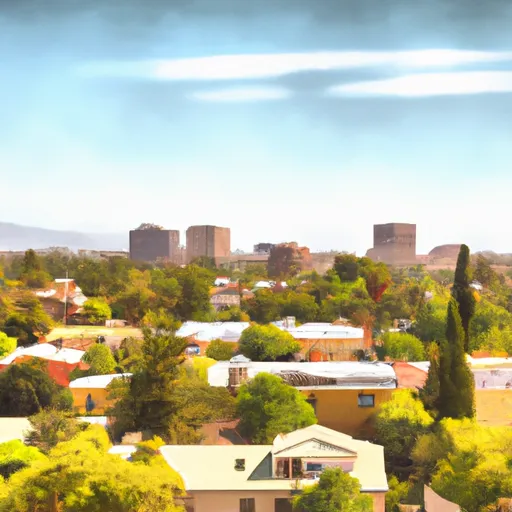-
 Snoflo Premium
Snoflo Premium
Get unlimited access to all our content
With no Ad interruptions! - Start Your Free Trial Login with existing account
South-Pasadena
Eden Index
Climate
9.5
•
Recreation
7.3
•
Community
3.5
•
Safeguard
7.2/10

South Pasadena, California is a charming city located in Los Angeles County. It enjoys a Mediterranean climate, characterized by mild, wet winters and warm, dry summers. The average temperature ranges from 45°F (7°C) in winter to 90°F (32°C) in summer, with minimal rainfall during the summer months.
Hydrology constituents in South Pasadena include the Arroyo Seco, a major tributary of the Los Angeles River. This watercourse, flanked by lush vegetation, provides a scenic backdrop for outdoor activities. The iconic Colorado Street Bridge spans the Arroyo Seco, offering picturesque views of the river and surrounding landscapes.
Outdoor enthusiasts in South Pasadena have numerous recreational opportunities. The city is home to beautiful parks and hiking trails, such as Arroyo Park and the Lower Arroyo Seco Trail. These green spaces provide opportunities for picnicking, walking, jogging, and cycling. For water-based activities, nearby attractions like the Rose Bowl Aquatic Center and the Pasadena Yacht and Country Club offer swimming, boating, and sailing options.
With its pleasant climate, scenic waterways, and diverse outdoor offerings, South Pasadena is a haven for those seeking to enjoy nature and engage in various recreational pursuits.
What is the Eden Index?
The Snoflo Eden Index serves as a comprehensive rating system for regions, evaluating their desirability through a holistic assessment of climate health, outdoor recreation opportunities, and natural disaster risk, acknowledging the profound impact of these factors on livability and well-being.
Climate Health Indicator (CHI): 9.5
South-Pasadena receives approximately
480mm of rain per year,
with humidity levels near 58%
and air temperatures averaging around
19°C.
South-Pasadena has a plant hardyness factor of
10, meaning
plants and agriculture in this region tend to thrive here all year round.
By considering the ideal temperature range, reliable water supplies, clean air, and stable seasonal rain or snowpacks, the Climate Health Indicator (CHI) underscores the significance of a healthy climate as the foundation for quality living.
A healthy climate is paramount for ensuring a high quality of life and livability in a region, fostering both physical well-being and environmental harmony. This can be characterized by ideal temperatures, reliable access to water supplies, clean air, and consistent seasonal rain or snowpacks.
Weather Forecast
Streamflow Conditions
Ventura-San Gabriel Coastal
Area Rivers
Ventura-San Gabriel Coastal
Snowpack Depths
Ventura-San Gabriel Coastal
Reservoir Storage Capacity
Ventura-San Gabriel Coastal
Groundwater Levels
Recreational Opportunity Index (ROI): 7.3
The Recreational Opportunity Index (ROI) recognizes the value of outdoor recreational options, such as parks, hiking trails, camping sites, and fishing spots, while acknowledging that climate plays a pivotal role in ensuring the comfort and consistency of these experiences.
Access to outdoor recreational opportunities, encompassing activities such as parks, hiking, camping, and fishing, is crucial for overall well-being, and the climate plays a pivotal role in enabling and enhancing these experiences, ensuring that individuals can engage in nature-based activities comfortably and consistently.
Camping Areas
| Campground | Campsites | Reservations | Toilets | Showers | Elevation |
|---|---|---|---|---|---|
| Gould Mesa | 7 | 1,418 ft | |||
| Seabreeze at Seal Beach Military | None | 15 ft | |||
| Sunset Vista RV Park | None | 19 ft | |||
| Oakwilde | 7 | 1,831 ft | |||
| Chilao | 111 | 5,333 ft | |||
| Millard | 5 | 1,980 ft | |||
| Glenn Camp | 8 | 2,095 ft | |||
| Devore | 6 | 2,914 ft | |||
| Bolsa Chica State Beach | 57 | 12 ft | |||
| Los Alamitos Army Military | None | 25 ft |
Catastrophe Safeguard Index (CSI):
The Catastrophe Safeguard Index (CSI) recognizes that natural disaster risk, encompassing floods, fires, hurricanes, and tornadoes, can drastically affect safety and the overall appeal of an area.
The level of natural disaster risk in a region significantly affects safety and the overall livability, with climate change amplifying these risks by potentially increasing the frequency and intensity of events like floods, fires, hurricanes, and tornadoes, thereby posing substantial challenges to community resilience and well-being.
Community Resilience Indicator (CRI): 3.5
The Community Resilience Indicator (CRI) recognizes that education, healthcare, and socioeconomics are crucial to the well-being of a region. The CRI acknowledges the profound impact of these elements on residents' overall quality of life. By evaluating educational resources, healthcare accessibility, and economic inclusivity, the index captures the essential aspects that contribute to a thriving community, fostering resident satisfaction, equity, and social cohesion.

